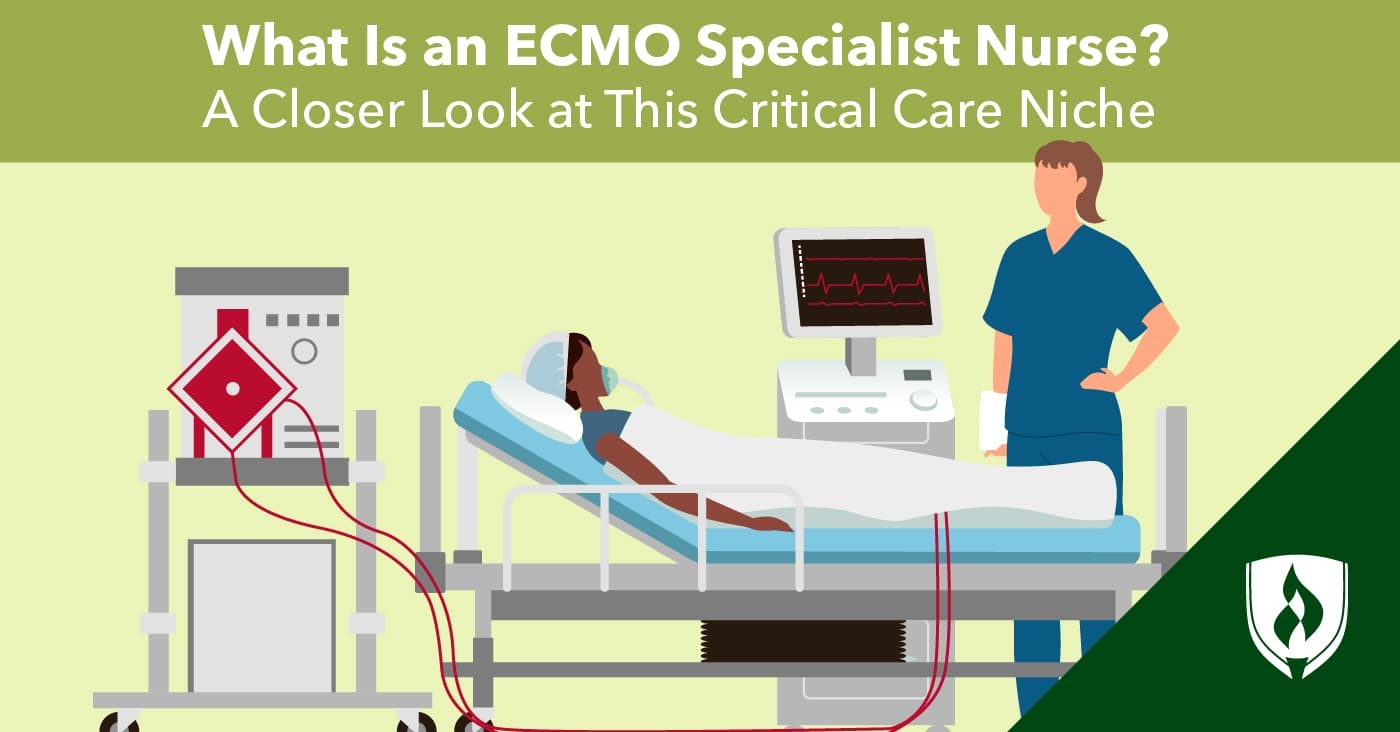What Is an ECMO Specialist Nurse? A Closer Look at This Critical Care Niche
By Kirsten Slyter on 04/11/2022

Love the idea of working in critical care nursing? The complex care, participation in intense procedures and narrow focus that comes with lower patient ratios can all have an allure. While the patients these nurses tend to are often too sick or sedated to carry on a conversation or say thank you, critical care nurses don’t mind—they just want to see their patients get better.
These units are unsurprisingly filled with specialized equipment and tools to help do just that. One tool you may have heard about is the extracorporeal membrane oxygenation (ECMO) machine. Whether you’ve ever worked with an ECMO patient or not, you may be intrigued by this machine and the trained staff who know how to use it.
Furthering the intrigue is that working with this specialized equipment isn’t just for respiratory therapists or cardiovascular perfusionists. Experienced ICU nurses who fulfill certain requirements can also be called on to help. Read on, and we’ll walk through what ECMO is, what ECMO nurse specialists do and how to become one.
What is ECMO?
Extracorporeal membrane oxygenation (ECMO) is a last resort therapy for some of the sickest patients in the hospital. It allows the heart and lungs to rest by pumping the patient’s blood into the machine, which oxygenates and warms the blood before pumping it back into the body through plastic tubes.
It can be used to help very sick patients with heart or lung conditions get the rest they need. It’s often used as a “bridge treatment” to help patients with cardiac or respiratory failure before and after cardiothoracic surgery. Often, ECMO patients are treated with mechanical ventilators as well. During this treatment, patients are sedated and given pain medications to make them more comfortable.
It’s important to note that ECMO is only a “life-sustaining treatment.” It does not cure or treat the disease or injury that led to heart or lung failure. This means that if the original condition is not improving, it may be very hard for the patient to get off ECMO support. This can make for difficult decisions about the patient’s quality of life going forward. It’s also important to note that this specialized treatment option isn’t universally available. Typically, only large medical centers have the resources to support ECMO care, so this can compound some of the challenging care decisions made during times of great demand.
Seeing a patient on an ECMO machine and ventilator can be a lot to take in—both mentally and emotionally. While you’ll start to understand more about the machine and process as you gain more experience, it can still be difficult to watch. “I will never forget the first patient I personally took care of who was on ECMO,” says Nakisa Baher, RN-BSN and ECMO nurse specialist at Bryan Health Medical Center. “You never really get used to seeing ECMO in action.”
What is an ECMO specialist nurse?
ECMO specialist nurses are registered nurses trained to manage the ECMO circuit for critically ill patients. While these nurses have backgrounds as staff critical care nurses, their focus as the ECMO specialist is the machine and knowing how to troubleshoot it in an emergency.
Many ECMO specialist nurses have backgrounds in the cardiovascular intensive care unit (CVICU) and often work separate shifts as a staff nurse in addition to their shifts as an ECMO specialist. The staff nurse caring for an ECMO patient must think about all of the patient’s needs while the ECMO specialist is hyper-focused on the patient’s vitals and how they are responding to the ECMO treatment.
Aside from ECMO nurse specialists, ECMO specialists can also include respiratory therapists, cardiovascular perfusionists and physicians who have undergone ECMO training.
What does a day in the life of an ECMO nurse look like?
Since ECMO is used on the sickest of the sick, your work can change at a moment’s notice if there’s an emergency, if the patient is being weaned off ECMO or if the patient or their family decides to withdraw life-saving measures.
Baher walked us through what a typical shift looks like as an ECMO nurse specialist. First, Baher says she gets the report from the previous shift’s ECMO specialist about the patients under their care. During this time, she’ll find out information like:
- What type of ECMO the patient is on (venoarterial or venovenous)
- The patient’s most recent arterial blood gas results
- What medications the patient is receiving
- The current ECMO settings
- Any significant events that occurred
After she receives this shift change report, Bahr reviews the ECMO circuit and ensures she doesn’t see any new problems like clots or kinked lines.
Over the course of her shift, a provider will come by to assess the patient. That usually includes a conversation about where the ECMO treatment is heading. If the patient’s labs are trending in the right direction, they’ll attempt to wean the patient off ECMO to see how they’re healing.
Throughout her shift, Bahr performs and charts assessments. If the patient has been on ECMO for more than 24 hours, Bahr will perform hourly assessments. If they’ve been recently started on ECMO, she’ll perform assessments more frequently. Throughout the whole shift, she keeps a close eye on their vitals to make sure they aren’t decompensating.
At the end of her shift, she passes on the report to the next ECMO specialist where the process starts over again.
How to become an ECMO specialist nurse
The first step on the road to becoming an ECMO nurse specialist is to become a registered nurse (RN). To become an RN, you’ll need a degree—either an Associate Degree in Nursing (ADN) or a Bachelor of Science in Nursing (BSN)—and meet all other requirements for state licensure. Once licensed, you’ll be qualified to apply to a variety of nursing positions.
When choosing your degree path, you should keep in mind that a BSN may be beneficial when going into critical care. Though ADN nurses complete just as many clinical hours as BSN nurses, BSN nursing students do additional coursework in leadership, understanding research and practice critical thinking on another level, which can be especially beneficial in ICU settings. ADN nurses can earn their BSN through RN to BSN programs.
Most ECMO specialist nurses are experienced ICU or CVICU nurses, so getting a job in an ICU or step-down unit is a great place to start. Remember, not every hospital can offer ECMO, so make sure you’re applying to those that do if this is a long-term goal. Those hospitals generally offer their own trainings guided by the Extracorporeal Life Support Organization (ELSO) where the ECMO specialists undergo initial training, continuing education and competency checks. You can also find initial training about ECMO through the American Association of Critical-Care Nurses (AACN).
Take the first step
Working as an ECMO nurse specialist is a unique way to apply yourself in a critical care role. Every day, these nurses use medical technology that almost sounds like science fiction to give very seriously ill patients another chance to fight back. Could this be the critical care nursing niche for you?
If so, the first step is to start down the path of becoming a registered nurse. Our article “How to Become a Registered Nurse: A Simple Step-by-Step Guide” lays out a straightforward view of what lies ahead.




